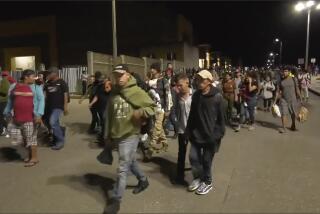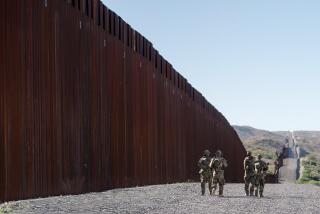The migrant caravan arrives at California’s doorstep, amid protests, cheers and questions

By foot, bus and train, the caravan migrants have been journeying through Mexico since leaving the southern border city of Tapachula on March 25.
A group of immigrants from Central America, whose caravan north drew the ire of President Trump and became a flash point in the roiling debate over illegal immigration, converged at the California border Sunday to request asylum in a scene marked by emotion and theater.
As the boisterous gathering at the border fence in Playas de Tijuana grew to hundreds, some waved Honduran flags, called out chants and waved bouquets of yellow flowers. Younger migrants climbed to the top of tall gates dividing the U.S. and Mexico, fist-pumping to crowds gathered on the American side. Others quietly clutched infants, wondering about their future.
The spectacle at the border, captured by multiple news outlets, was sure to further fan the ire of Trump, who has frequently cited the caravan as a justification for tough measures against illegal immigration.
“Are you watching that mess that’s going on right now with the caravan coming up?” he told a crowd at a rally in Michigan Saturday. “We have the worst laws anywhere in the world, we don’t have borders.”
By foot, bus and train, the caravan migrants have been journeying through Mexico since leaving the southern border city of Tapachula on March 25 with the goal of reaching the Tijuana-San Diego border. Most are from Honduras and tell of gang violence and extortion back home.
Reina Isabel Rodriguez, 52, traveled from El Salvador with her two grandchildren. “I fear that they will separate me from them,” she said.
Those expected to ask for asylum are a small percentage of a traveling group that organizers said at one point swelled to more than 1,700 people. They said that about 400 of them, many of them women and children, had completed the journey to Tijuana, and some small groups have already been surrendering to American authorities at the San Ysidro Port of Entry in recent days.
Others may have to remain in Tijuana longer before they can be processed by U.S. authorities.
David Lopez was among dozens pondering their next move. Lopez, 25, who until recently worked on the staff of an elementary school, said “organized crime and our country’s government” had prompted him to flee the Copan area of Honduras with his wife and their 3-year-old daughter.
He said his wife and daughter asked for asylum at the San Ysidro Port of Entry 10 days ago, but he stayed behind. They are now staying in South Carolina while their claim is under review.
What happens to those people who have made this journey for quite a few weeks now, and they get rejected or ... they don’t even get their asylum cases heard?
— Rev. Patrick Murphy
Generally, when asylum seekers come to the U.S. border, they begin a process that can take months, or even years, to resolve. Many spend most, if not all, of that time in detention facilities run by private prison companies contracted with Immigration and Customs Enforcement.
They are interviewed and screened by multiple federal agencies, and at the end, they have to prove to judges that their stories meet the requirements under asylum law to be granted protection.
Caravans for years have traveled through Mexico as a way of keeping Central Americans safe from criminal gangs and corruption. But this is one of the largest and by far the most visible, having provoked a series of jabs by Trump, who has complained that Mexico is doing little to stop the group from reaching the U.S. border.
At Saturday’s rally, Trump hyped the $1.6 billion secured in funding to build a border wall. “We come up again on Sept. 28,” he said, referring to the fall spending bill, “and if we don’t get border security, we have no choice; we’ll close down the country because we need border security.”
While the wild publicity has complicated the journey, “it’s been really, really good that we are able to see what is the problem,” said Irineo Mujica, leader of the Pueblo Sin Fronteras Caravan, referring to the violence that is causing so many to abandon their homes.
Still, some migrant advocates have questioned the caravan’s benefits.
“We don’t think it’s a really good move,” said the Rev. Patrick Murphy, who heads the Catholic-run Casa del Migrante, a 120-bed shelter that overlooks the city. “What happens to those people who have made this journey for quite a few weeks now, and they get rejected, or worse yet, they don’t even get their asylum cases heard?”
In a statement last week, U.S. Homeland Security Secretary Kirstjen Nielsen said the department has been “closely monitoring” the remnants of the caravan. She said the agency “encourages persons with asylum or other similar claims to seek protections in the first safe country they enter, including Mexico.”
But Maureen Meyer of the Washington Office on Latin America, a human rights advocacy group, said that “it’s naive to think that most of the Central Americans will want to request asylum in Mexico.”
While Mexico “has increased its capacity to process and screen potential asylum seekers, it still has a long way to go,” she said. “With widespread kidnappings, theft, sexual assaults and other crimes against migrants in Mexico, it is hard to think that Central Americans will view Mexico as a place they want to settle.”
While the odds of getting into the U.S. might be long, some Americans like Blair Overstreet and her husband, Matt Dunn, said they would welcome some of those migrants who gained asylum into their homes to help them get a new start.
The idea of opening up their two-bedroom, one-bath apartment to a stranger just made sense to the San Diego couple — both 36 years old.
“It’s a humanitarian issue,” Dunn said.
It’s also political. The couple and others like them are taking a stand at a time when the nation seems starkly divided on who should be allowed to reside in the United States and what it means to be American.
Even in progressive California, where state leaders approved sanctuary laws to protect people who are in the country without legal status, an anti-sanctuary movement quickly followed and appears to be gaining momentum.
“The willingness of these people to house these immigrants reflects that there is a division in the United States and in California over the appropriate course of immigration policy,” said Louis DeSipio, a professor of political science at UC Irvine.
About 75 people have expressed interest in housing at least one asylum seeker, said Heather Cronk, co-director of Showing Up for Racial Justice, which is coordinating volunteer sponsors. Some are from major metropolitan areas in California and New York. Others are from remote and rural areas in Montana and North Dakota.
“I think this is 100% about who we want to be as a nation,” she said. “Not only are we providing material support, supporting those who are in need of a place to go … We offer a counter message. We want to make very clear to the folks who are in the caravan and those across the country that Trump’s voice is not the only voice in this country. Where Trump closes doors, we open them.”
Though the caravan is relatively small compared with prior waves of immigration, like the tens of thousands of Haitians who petitioned for asylum at the San Ysidro Port of Entry two years ago, the media attention on the caravan has been amplified by the Trump presidency.
“President Trump has sort of raised this group beyond probably the level they really merit,” DeSipio said. “The caravan was on ‘Fox and Friends’ and that got the president’s attention and that made it, in his mind, representative of a larger phenomenon. ... People are now traveling in groups for their safety, but that somehow makes it seem more ominous.”
Dibble, who writes for the San Diego Union-Tribune, reported from Tijuana, Carcamo and Tchekmedyian from Los Angeles. Kate Morrissey, who writes for the San Diego Union-Tribune, contributed to this report.
More to Read
Start your day right
Sign up for Essential California for news, features and recommendations from the L.A. Times and beyond in your inbox six days a week.
You may occasionally receive promotional content from the Los Angeles Times.








